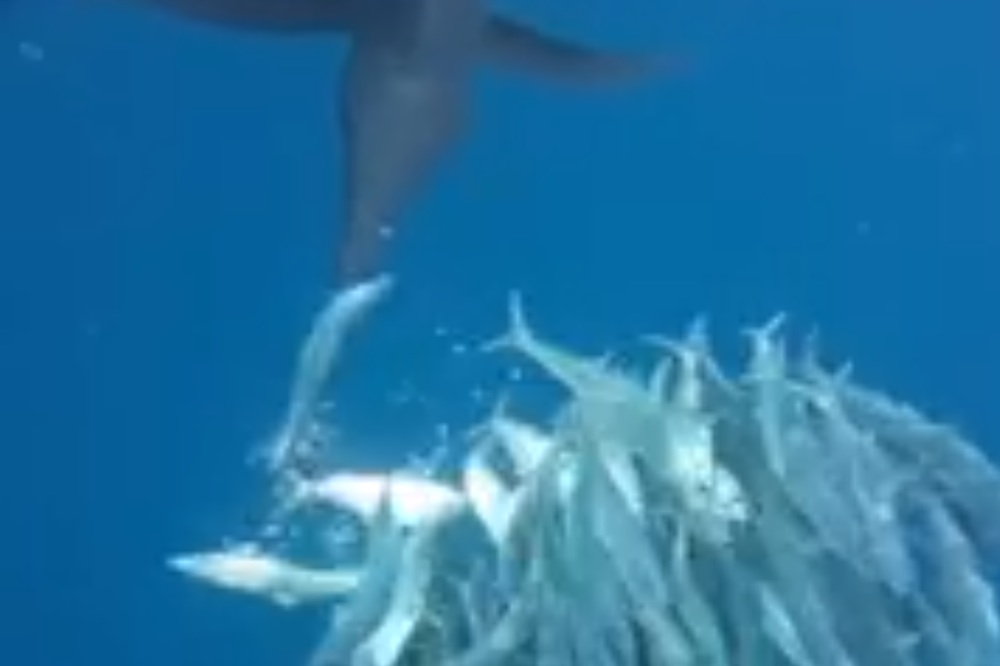Sailfish Stealthily Slash Prey with Bills

The purpose of a sailfish's iconic bill has long been a mystery. But now, new high-speed video of sailfish on the hunt reveals the fish use their bills to sneak into schools of fish before slashing and jabbing their prey.
After braving high seas and disruptive dolphins to capture the footage, researchers analyzed these high-speed sailfish videos frame-by-frame and found that the bills give their carnivorous owners the advantage of surprise. Schooling sardines don't seem to notice the slender bill poking into their midst until the blows start raining down.
"It's this combination of stealth and very high acceleration that makes this type of attack so powerful," said study researcher Jens Krause, an ecologist at the Leibniz Institute of Freshwater Ecology and Inland Fisheries and Humboldt University in Berlin. "It's a highly specialized form of attack." [Photos: The Biggest, Baddest Fish on Earth]
Evasive enigma
Krause and his colleagues were fascinated by the mystery of the sailfish, which is one of the fastest (and flashiest) fish in the ocean. Marine scientists have suggested the fish's trademark bill might help it slice through the water more effectively. Analyses of sailfish stomach contents turned up fish with slash marks, suggesting the animals might use the bills for hunting. But the slash marks were far from universal.
Part of the problem in solving the mystery is that sailfish hunt in the open ocean and are hard to observe. On a fish-hunting trip to Cancun, Mexico, Krause learned of a way to track these oceanic hunters, however. Local guides go offshore and search the horizon for flocks of seabirds. These birds mark places where hunting Atlantic sailfish (Istiophorus albicans) have pushed schools of sardines or other small fish to the surface.
Over a period of six days, the researchers donned snorkels and leaped into the water to film the hunts going on just below the surface. The work was challenging: The sardines sped off like silver darts trying to evade their predators, making it hard for human swimmers to keep up. The waves could be vicious — one day, all but one member of the team got seasick from body surfing the roiling ocean, Krause told Live Science. And sometimes, after all the effort to position themselves perfectly, the researchers found themselves stymied by dolphins, which sped in and dispersed the schools in their own hunt.
Sign up for the Live Science daily newsletter now
Get the world’s most fascinating discoveries delivered straight to your inbox.
"They destroy everything very quickly," Krause said of the dolphin interlopers.
But when conditions were good, the sardines would actually shelter behind the divers' bodies, making it possible to film sailfish attacks on the schools from as little as about 10 feet (3 meters) away.
Swordfish slashers
The footage revealed how the sailfish wield their bills. Groups of the predators hunt and herd the schools of sardines. Then, one by one, they stealthily insert their bills into the schools. The sardines don't react, Krause said, indicating the prey don't notice the intrusion.
Next, the sailfish either swing their bills rapidly, sending multiple sardines reeling, or single out one for an attack in a behavior known as "tapping."
"Very often the fish get injured multiple times before capture," Krause said. The less-showy tapping behavior ends with capture more often than the indiscriminate slashing.
The acceleration of the sailfish bill during the attack ranks among the fastest speeds seen in marine animals, Krause said. The tip of the bill could accelerate as quickly as 430 feet per second squared (131 meters per second squared).
The findings, published today (April 22) in the journal Proceedings of the Royal Society B, reveal an unknown evolutionary adaption in the hunting of schooling fish, Krause said. Fish (like birds and even humans) group together for safety. In the open ocean, where cover is nonexistent, schools make for a good defense. Predators have evolved strategies to overcome this defense, Krause said. Dolphins, for example, try to break up schools and hunt down stragglers. Killer whales and thresher sharks swing their tails into schools from the outside to stun prey. But sailfish have evolved a sneakier solution, Krause said.
"The sailfish can put the bill inside the school and they don’t seem to notice it, because it is so long and thin. And then," he said, "it will hit them."
Follow Stephanie Pappas on Twitter and Google+. Follow us @livescience, Facebook & Google+. Original article on Live Science.

Stephanie Pappas is a contributing writer for Live Science, covering topics ranging from geoscience to archaeology to the human brain and behavior. She was previously a senior writer for Live Science but is now a freelancer based in Denver, Colorado, and regularly contributes to Scientific American and The Monitor, the monthly magazine of the American Psychological Association. Stephanie received a bachelor's degree in psychology from the University of South Carolina and a graduate certificate in science communication from the University of California, Santa Cruz.









